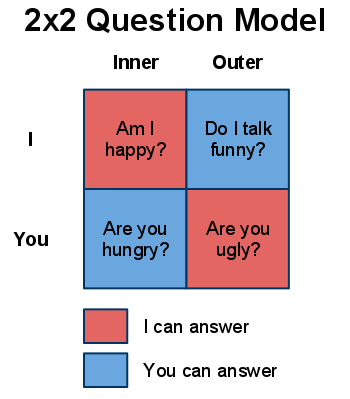Why do we develop insecurities?
Have you ever seen a picture of the back of your head? Or seen yourself in a video? Chances are the voice you hear in a recording does not match the voice you think you have. The same goes for our appearances. The problem is we cannot answer questions about physical appearances, even though we think we can.
We perceive the world with our senses, like everyone else, but we inherently subjective when we try and answer questions like:
- Do I look like Steve Carell?
- Do you think I look fat?

The Question Model
Everything in life can be summarized in a 2×2 matrix, and it is no different when we consider what types of questions we can answer:

The 2×2 question matrix is quite simple. An individual can directly answer questions relating to his inner thoughts and feelings, and about the outside world around him. The only way he can gain insight into his outer self and the thoughts of other people is via communication. The more direct the communication the more accurate the answer. People may develop different You-Inner’s from a single I-Outer. The classic example is “beauty is in the eye of the beholder”.

Some of you might be thinking the matrix is flawed since you can use various techniques to work around the limitation of the model:
- Look in a mirror to judge your I-Outer
- Use body language to gauge a person’s You-Inner
The problem with these techniques is that they rely on indirect communication, which leaves them open to error. Just compare how you look in the mirror with a picture of yourself taken by a camera Which do you think looks more accurate? Body language may act as a vague barometer for You-Inner questions, but we cannot get specific details without direct communication. Think of it this way, when was the last time you knew you had an eye lash on your cheek?
Insecurities and the Question Model
The reason we develop insecurities is because we either lack information or cannot control our I-Outer; subsequently, we cannot control how people develop You-Inner’s. The only lever we control is our I-Inner’s: how we choose to feel about someone perceiving a flaw with our I-Outer self. (We can also prevent people from seeing our true I-Outer by wearing makeup, being anti-social, etc)

Example case
Ben is studying inside a classroom alone. It is a hot summer day, and unfortunately Ben forgot to apply antiperspirant. He has developed an odour in the humid weather.
- Ben cannot smell his own odour (I-Inner cannot objectively perceive I-Outer, just like how you can’t hear your own true voice)
- Jerry walks into the classroom, smells a foul odour (from Ben’s perspective, Jerry objectively perceives Ben’s I-Outer)
- Jerry thinks Ben smells (You-Inner)
Outcome I
- Jerry tells Ben that he smells (direct communication)
- Ben is aware that Jerry thinks he smells, becomes insecure
Outcome II
- Jerry says something smells in the room (indirect communication)
- Ben is aware something may smell in the room but is unsure if he smells
- The indirect communication may cause a more greater anguish
In this example, there were three steps required to create the insecurity:
- You perceive my I-Outer self
- You develop a negative You-Inner about my I-Outer
- I develop a negative I-Inner about my I-Outer (via direct or indirect communication)
The most important step is the final one. If there is no communication between You and I, the insecurity cannot develop. Ignorance is bliss.
Conclusion
I came across this question model from my Grade 9 / 10 religion teacher from Notre Dame. It has helped me with the way I think about insecurities, especially my I-Outer. For this reason I never go shopping for glasses or a suit without a female companion.
The world around us is composed of endless I-Inner, I-Outer, You-Inner, and You-Outer questions, and the only way we can fully comprehend it all is with communication. Or IBM’s Watson computer.









Leave your response!